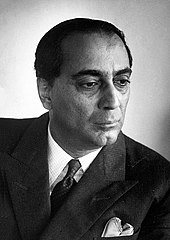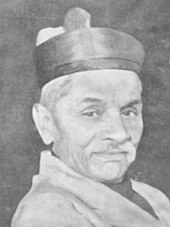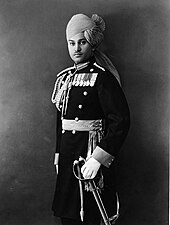List of Padma Bhushan award recipients (1954–1959)
Template:Infobox Indian Awards
The Padma Bhushan is the third-highest civilian award of the Republic of India.[1] Instituted on 2 January 1954,[2] the award is given for "distinguished service of a high order", without distinction of race, occupation, position, or sex. The recipients receive a Sanad (certificate) signed by the President of India and a circular-shaped medallion with no monetary grant associated with the award. The Padma Bhushan award recipients are announced every year on Republic Day and registered in The Gazette of India—a publication released weekly by the Department of Publication, Ministry of Urban Development used for official government notices.[3] The conferral of the award is not considered official without its publication in the Gazette. Recipients whose awards have been revoked or restored, both of which require the authority of the President, are also registered in the Gazette and are required to surrender their medals when their names are struck from the register.[4] None of the conferments of Padma Bhushan during 1954–59 have been revoked or restored. The recommendations are received from all the state and the union territory governments, the Ministries of the Government of India, the Bharat Ratna and the Padma Vibhushan awardees, the Institutes of Excellence, the Ministers, the Chief Ministers and the Governors of State, and the Members of Parliament including private individuals.[3]
When instituted in 1954, the Padma Bhushan was classified as "Dusra Warg" (Class II) under the three-tier Padma Vibhushan awards; preceded by the Bharat Ratna. The original specification of the award was a circle made of standard silver 1+3⁄8 inches (35 mm) in diameter, with rims on both the sides. A centrally located lotus flower was embossed on the obverse side of the medal and the text "Padma Vibhushan" written in Devanagari script was inscribed above the lotus along the upper edge of the medal. A floral wreath was embossed along the lower edge and a lotus wreath at the top along the upper edge. The State Emblem of India was placed in the centre of the reverse side with the text "Desh Seva" in Devanagari Script on the lower edge. The medal was suspended by a pink riband 1+1⁄4 inches (32 mm) in width divided into three equal segments by two white vertical lines.[2]
On 15 January 1955, the Padma Vibhushan was reclassified into three different awards; the Padma Vibhushan, the highest of the three, followed by the Padma Bhushan and the Padma Shri. The criteria includes "distinguished service of a high order in any field including service rendered by Government servants" but excluding those working with the Public sector undertakings with the exception of doctors and scientists. The 1954 statutes did not allow posthumous awards but this was subsequently modified in the January 1955 statute. The design was also modified to the form that is currently in use. The current design is a circular-shaped toned bronze medallion 1+3⁄4 inches (44 mm) in diameter and 1⁄8 inch (3.2 mm) thick. The centrally placed pattern made of outer lines of a square of 1+3⁄16 inches (30 mm) side is embossed with a knob embossed within each of the outer angles of the pattern. A raised circular space of diameter 1+1⁄16 inches (27 mm) is placed at the centre of the decoration. A centrally located lotus flower is embossed on the obverse side of the medal and the text "Padma" written in Devanagari script is placed above and the text "Bhushan" is placed below the lotus. The Emblem of India is placed in the centre of the reverse side with the national motto of India, "Satyameva Jayate" (Truth alone triumphs) in Devanagari Script, inscribed on the lower edge. The rim, the edges and all embossing on either side is of standard gold with the text "Padma Bhushan" of gold gilt. The medal is suspended by a pink riband 1+1⁄4 inches (32 mm) in width with a broad white stripe in the middle.[3][4] It is ranked fifth in the order of precedence of wearing of medals and decorations.[5]
A total of twenty-three awards were conferred in 1954 followed by twelve in 1955; thirteen in 1956; sixteen in 1957; sixteen again in 1958, and fourteen in 1959, giving a total of 94 recipients in the first six years—including one foreign recipient awarded in 1955. Till 1959, individuals from nine different fields were awarded which includes twenty-six from literature and education, seventeen from civil service, twelve artists, ten from science and engineering, ten from social work, eight from public affairs, six from medicine, four sports-persons, and one from trade and industry.
List of recipients








|
|
|---|
| Year | Recipient | Field | State |
|---|---|---|---|
| 1954 | Homi Jehangir Bhabha | Science & Engineering | Maharashtra |
| 1954 | Shanti Swaroop Bhatnagar | Science & Engineering | Uttar Pradesh |
| 1954 | Mahadeva Iyer Ganapati | Civil Service | Odisha |
| 1954 | Jnan Chandra Ghosh | Science & Engineering | West Bengal |
| 1954 | Radha Krishan Gupta | Civil Service | Delhi |
| 1954 | Maithili Sharan Gupt | Literature & Education | Uttar Pradesh |
| 1954 | R. R. Handa | Civil Service | Punjab |
| 1954 | Amarnath Jha | Literature & Education | Uttar Pradesh |
| 1954 | Ajudhiya Nath Khosla | Science & Engineering | Delhi |
| 1954 | Kariamanickam Srinivasa Krishnan | Science & Engineering | Tamil Nadu |
| 1954 | Moulana Hussain Ahmed Madni | Literature & Education | Punjab |
| 1954 | Josh Malihabadi | Literature & Education | Delhi |
| 1954 | V. L. Mehta | Public Affairs | Gujarat |
| 1954 | Vallathol Narayana Menon | Literature & Education | Kerala |
| 1954 | A. Lakshmanaswami Mudaliar | Literature & Education | Tamil Nadu |
| 1954 | Maharaj Kr. Palden T Namgyal | Public Affairs | Punjab |
| 1954 | V. Narahari Rao | Civil Service | Karnataka |
| 1954 | Pandyala Satyanarayana Rau | Civil Service | Andhra Pradesh |
| 1954 | Jamini Roy | Arts | West Bengal |
| 1954 | Sukumar Sen | Civil Service | West Bengal |
| 1954 | Satya Narayana Shastri | Medicine | Uttar Pradesh |
| 1954 | M. S. Subbulakshmi | Arts | Tamil Nadu |
| 1954 | Kodandera Subayya Thimayya | Civil Service | Karnataka |
| 1955 | Fateh Chand Badhwar | Civil Service | Punjab |
| 1955 | Lalit Mohan Banerjee | Medicine | West Bengal |
| 1955 | Suniti Kumar Chatterji | Literature & Education | West Bengal |
| 1955 | Kamaladevi Chattopadhyay | Social Work | West Bengal |
| 1955 | Surender Kumar Dey | Civil Service | – [a] |
| 1955 | Vasant Ramji Khanolkar | Medicine | Maharashtra |
| 1955 | Sunder Das Khungar | Civil Service | Punjab |
| 1955 | Rameshwari Nehru | Social Work | Uttar Pradesh |
| 1955 | Prana Krushna Parija | Literature & Education | Odisha |
| 1955 | Madapati Rao | Social Work | Andhra Pradesh |
| 1955 | Maneklal Sankalchand Thacker | Literature & Education | Delhi |
| 1955 | Attur Rangaswami Venkatachari | Civil Service | Tamil Nadu |
| 1956 | Rukmini Devi Arundale | Arts | Tamil Nadu |
| 1956 | Rajshekhar Basu | Literature & Education | West Bengal |
| 1956 | Dhyan Chand | Sports | Punjab |
| 1956 | Malur Srinivasa Thirumale Iyengar | Civil Service | Tamil Nadu |
| 1956 | Nawab Zain Yar Jung | Public Affairs | Andhra Pradesh |
| 1956 | Pushpavati Janardenrai Mehta | Public Affairs | Maharashtra |
| 1956 | Cottari Kankaiyah Nayudu | Sports | Tamil Nadu |
| 1956 | Muthulakshmi Reddi | Medicine | Tamil Nadu |
| 1956 | Kanwar Sain | Civil Service | Rajasthan |
| 1956 | Vir Singh | Literature & Education | Punjab |
| 1956 | Kasturi Srinivasan | Literature & Education | Punjab |
| 1956 | Mahadevi Varma | Literature & Education | Uttar Pradesh |
| 1956 | Triuvadi Sambasiva Venkataraman | Science & Engineering | Tamil Nadu |
| 1957 | Bhikham Lal Atreya | Literature & Education | Uttar Pradesh |
| 1957 | T. Balasaraswati | Arts | Tamil Nadu |
| 1957 | Alagappa Chettiar | Social Work | Tamil Nadu |
| 1957 | Hazari Prasad Dwivedi | Literature & Education | Uttar Pradesh |
| 1957 | Abid Hussain | Literature & Education | Uttar Pradesh |
| 1957 | Mushtaq Hussain Khan | Arts | Madhya Pradesh |
| 1957 | Lakshmi Menon | Public Affairs | Kerala |
| 1957 | Radha Kumud Mukherjee | Public Affairs | West Bengal |
| 1957 | K. Covilagam Kutti Ettan Raja | Civil Service | Kerala |
| 1957 | Andal Venkatasubba Rao | Social Work | Andhra Pradesh |
| 1957 | Shrikrishna N. Ratanjankar | Arts | Uttar Pradesh |
| 1957 | Shyam Nandan Sahay | Literature & Education | Bihar |
| 1957 | Govind Sakharam Sardesai | Literature & Education | Maharashtra |
| 1957 | K. A. Nilakanta Sastri | Literature & Education | Tamil Nadu |
| 1957 | Boshi Sen | Science & Engineering | West Bengal |
| 1957 | Siddheshwar Varma | Literature & Education | Chandigarh |
| 1958 | Salim Ali | Science & Engineering | Maharashtra |
| 1958 | Vijaya Anand | Sports | Uttar Pradesh |
| 1958 | D. P. Roy Choudhury | Arts | West Bengal |
| 1958 | Jeahangir Ghandy | Trade & Industry | Maharashtra |
| 1958 | Narayan Subarao Hardikar | Social Work | Karnataka |
| 1958 | Ariyakudi Ramanuja Iyengar | Arts | Tamil Nadu |
| 1958 | Allauddin Khan | Arts | Uttar Pradesh |
| 1958 | Kumar Padma Siva Shankara Menon | Civil Service | Kerala |
| 1958 | Arathil C. Narayanan Nambiar | Civil Service | Kerala |
| 1958 | Kuppali Venkatappagowda Puttappa | Literature & Education | Karnataka |
| 1958 | Poola Tirupati Raju | Literature & Education | Rajasthan |
| 1958 | Kamalendumati Shah | Social Work | Delhi |
| 1958 | Rao Raja Hanut Singh | Public Affairs | Rajasthan |
| 1958 | Rustom Jal Vakil | Medicine | Maharashtra |
| 1958 | Surya Narayan Vyas | Literature & Education | Madhya Pradesh |
| 1958 | Darashaw Nosherwan Wadia | Science & Engineering | Maharashtra |
| 1959 | Sisir Kumar Bhaduri[b] | Arts | West Bengal |
| 1959 | Ramdhari Singh Dinkar | Literature & Education | Bihar |
| 1959 | Ali Yavar Jung | Civil Service | Maharashtra |
| 1959 | Hansa Jivraj Mehta | Social Work | Maharashtra |
| 1959 | Pammal Sambandha Mudaliar | Arts | Tamil Nadu |
| 1959 | Tiruppattur R. Venkatachala Murthi | Literature & Education | Tamil Nadu |
| 1959 | Tenzing Norgay | Sports | West Bengal |
| 1959 | Bhaurao Patil | Social Work | Maharashtra |
| 1959 | Jal Gawashaw Paymaster | Medicine | Maharashtra |
| 1959 | Dhanvanthi Rama Rau | Social Work | Maharashtra |
| 1959 | Nirmal Kumar Sidhanta | Literature & Education | West Bengal |
| 1959 | Kankanhalli Vasudevachary | Arts | Karnataka |
| 1959 | Bhargavaram Viththal Varerkar | Public Affairs | Maharashtra |
| 1959 | Ghulam Yazdani | Science & Engineering | Andhra Pradesh |
Explanatory notes
References
- ^ "Who's getting a Padma? Bill and Melinda Gates, L.K. Advani and Dilip Kumar honoured with prestigious award". Daily Mail. Mail Online. 26 January 2015. Retrieved 28 October 2015.
- ^ a b Lal, Shavax A. (1954). "The Gazette of India—Extraordinary—Part I" (PDF). The Gazette of India. The President's Secretariat (published 2 January 1954): 2. Archived from the original (PDF) on 14 May 2014. Retrieved 26 September 2015.
The President is pleased to institute an award to be designated 'Padma Vibhushan' in three classes, namely: 'Pahela Varg', 'Dusra Varg' and 'Tisra Varg'
- ^ a b c "Padma Awards Scheme" (PDF). Ministry of Home Affairs (India). Retrieved 28 September 2015.
- ^ a b Ayyar, N. M. (1955). "The Gazette of India—Extraordinary—Part I" (PDF). The Gazette of India. The President's Secretariat (published 15 January 1955): 8. Archived from the original (PDF) on 18 May 2014. Retrieved 26 September 2015.
All persons upon whom the decoration of 'Padma Vibhushan' ('Dusra Varg') was conferred under the Regulations issued with Notification No. 2-Pres./54, dated the 2nd January, 1954, shall, for all purposes of these regulations, be deemed to be persons on whom the decoration of Padma Bhushan has been conferred by the President.
- ^ "Wearing of Medals: Precedence Of Medals". Indian Army. Retrieved 22 November 2015.
- ^ Richelson, Jeffrey (13 April 2006). "U.S. Intelligence and the Indian Bomb". The National Security Archive. National Security Archive Electronic Briefing Book No. 187. Retrieved 27 September 2015.
- ^ "Tata Institute of Fundamental Research: History & Archives". Tata Institute of Fundamental Research. Retrieved 23 September 2015.
- ^ "Bhabha Atomic Research Centre: Founder/Heritage". Bhabha Atomic Research Centre. Retrieved 23 September 2015.
- ^ "Discover hockey's answer to Pele". BBC Sports Academy. BBC. Retrieved 22 October 2015.
- Dhaliwal, Ravi (28 August 2009). "Dhyan Chand: Player, legend and the man". The Tribune. Muktsar. Retrieved 22 October 2015.
- ^ Meduri, Avanthi (2 March 2001). "Rukmini Devi, the visionary". The Hindu. Retrieved 23 September 2015.
- ^ Kumbhojkar, Shraddha, ed. (2009). 19th Century Maharashtra: A Reassessment. Cambridge Scholars Publishing. 19. ISBN 978-1-4438-0603-9.
- Sardesai, G.S. (2012). Marathi Riyasat. Popular Prakashan Pvt Ltd. ISBN 978-81-7185-640-4.
- Sardesai, G.S. (2012). Musalmani Riyasat. Popular Prakashan Pvt Ltd. ISBN 978-81-7185-673-2.
- Sardesai, G.S. (2012). British Riyasat. Popular Prakashan Pvt Ltd. ISBN 978-81-7185-674-9.
- ^ "Give Bharat Ratna to Salim Ali, demands AMU professor". IBN Live. 26 November 2013. Retrieved 23 September 2015.
- ^ "Supplement to the London Gazette, 1 January, 1921" (PDF). London Gazette. His Majesty's Stationery Office (published 21 January 1921): 2. 1921. Retrieved 25 September 2015.
To be Honorary Captain:Rao Rlaja Hanut Singh, son of His Highness Maharaja Sir Partap Singh Bahadur, Riegent of Jodhpur.
- Chakraborty Lahiri, Samhita (17 December 2010). "Chukker of life: Polo season 2010". The Telegraph. Calcutta. Retrieved 25 September 2015.
- ^ Muthiah, S. (30 July 2003). "The Mount Road congregations". The Hindu. Retrieved 4 June 2016.
- ^ Morris, Jan (14 June 1999). "The Conquerors Hillary & Tenzing". Time. Retrieved 25 September 2015.
{{cite journal}}: Cite journal requires|journal=(help); Italic or bold markup not allowed in:|publisher=(help) - ^ a b c "List of recipients of Padma Bhushan awards (1954–59)" (PDF). Ministry of Home Affairs (India). 14 August 2013. pp. 1–9. Retrieved 23 August 2015.
- ^ Sarkar, Chanchal (3 June 2001). "When is an apology not an apology: The losers". The Tribune. Retrieved 21 November 2015.
External links
- "Awards & Medals". Ministry of Home Affairs (India). 14 September 2015. Retrieved 22 October 2015.

